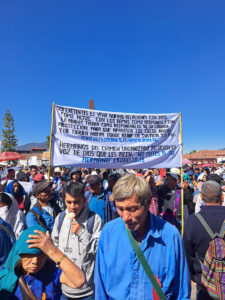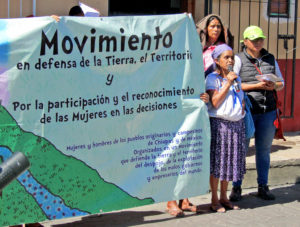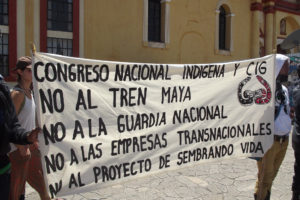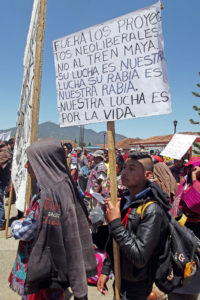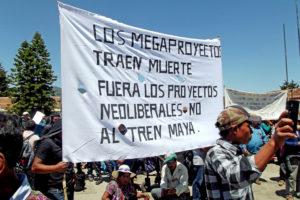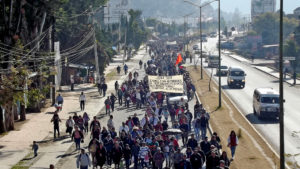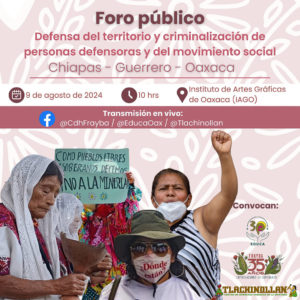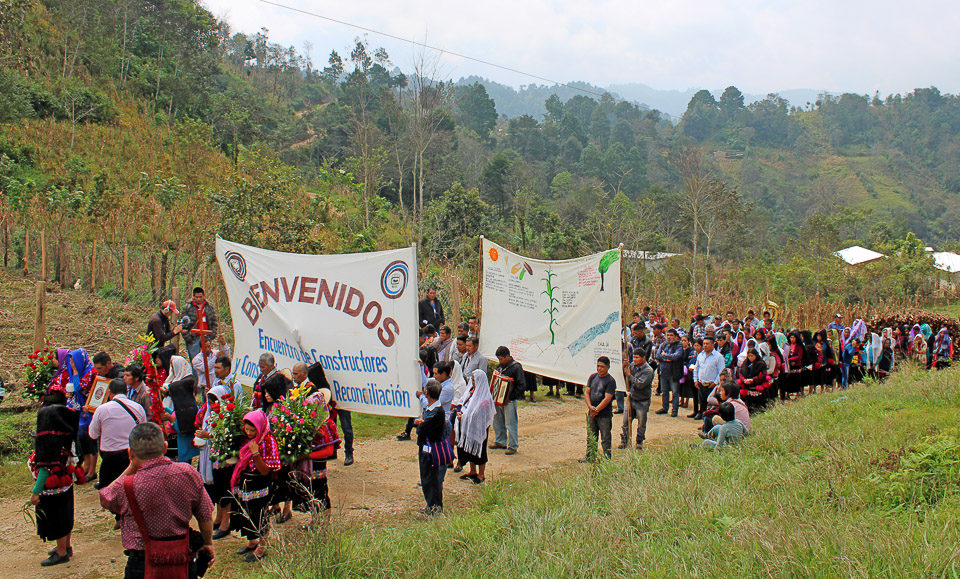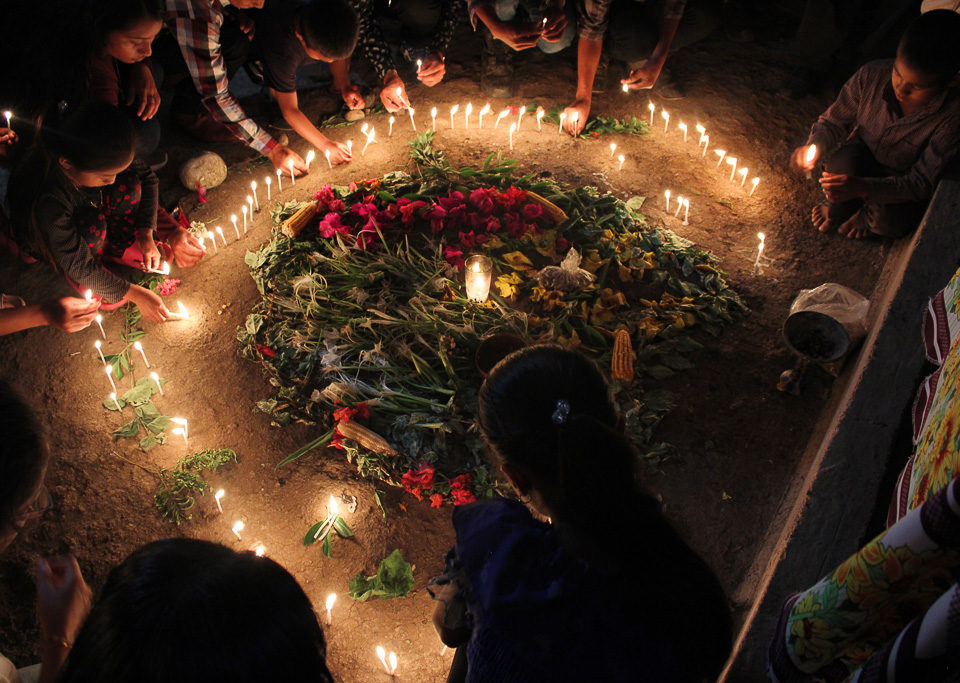
LATEST: MORENA Wins Landslide Victory in Mexican Elections
18/09/2024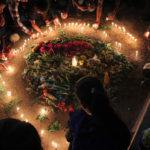
ARTICLE: Strengthening the Heart to Continue Building Peace
18/09/2024
We see with hope the globalizing force of the excluded, who do not accept that this system is the definitive one, but who vehemently express that another system, where justice and truth shine, is urgent and possible
The past history, like that with lowercase, is nothing more than the antecedent of the present nightmare. Today the death and destruction of tomorrow are being wrought
Development… For whom?
T he history of the south-southeast region, where Chiapas, Guerrero and Oaxaca are located, has been marked by important social mobilizations. The set of geographic, political, economic and social characteristics, as well as the wealth of resources and strategic geopolitical location, have made this region meet the conditions of conflict conducive to the emergence of various social movements, which have been a historical constant in the territory. Movements that arise as processes of legitimate resistance for the protection of their territory, their resources and their ways of life.
Since the government of Salinas de Gortari (1988-1994), the great promoter of neoliberal policy, the model of economic development in Mexico has been based on the indiscriminate plundering of strategic resources located mostly in indigenous territories; this dispossession is promoted to maximize the control of large companies over natural resources and territory, while the Mexican government has shown no interest in guaranteeing that indigenous peoples can exercise their collective and agrarian rights.
The drive for extractive policy has involved a series of legislative reforms that began in 1992, both in the Mexican Constitution and in secondary laws. The first reform was that of Article 27 of the Constitution, followed by the reform of the Agrarian Law and the creation of a mining law. The modification of article 27 had as its main objective curbing communal or ejido property, as well as weakening collective organization and decisions related to the destiny of territory. The Mining Law implied that this activity legally acquired the character of general interest and public utility. Consequently, mining companies had preferential access to exploit land and water over any other use. This law was reformed in 1996, 2005, 2006 and 2014, strengthening a legal framework that allows the legal plundering of natural resources in indigenous and campesino territories by promoting and endorsing private investment (national and foreign) in socially owned lands.
On the other hand, the extractive model has been articulated through relations with criminal groups that have positioned themselves and settled in strategic enclaves. Not only have they violated the collective rights of communities to decide on their natural resources, but they have also established conditions of siege, political and social control where companies operate comfortably. In the last stage, criminal groups have competed for territorial control to obtain greater profits and have diversified their economies, not only drugs, arms or migrant trafficking but also legal businesses, mining, for example, being a highly profitable business thanks to million-dollar extortions.
Currently, the neo-developmentalist model of the 4T continues to privilege extractive activities over the ways of life of people, towns and communities, according to several analysts. The political proposal of the current president, Andres Manuel Lopez Obrador (AMLO), has not implied a change in the development model in Mexico that has been promoted for decades. In the national agenda of this last six-year term there have been at least 1,600 projects and megaprojects to be carried out. In the Southeast of the country, a priority region for the AMLO government, a policy very similar to that of previous governments has been maintained, including the continuity of mining concessions granted by previous governments, the modernization of refineries, the development project of the Tehuantepec Isthmus (or Interoceanic Corridor) and the Maya Train.
Even in 2021, the federal government published a decree declaring government-run projects that are considered priority and strategic to be of “public interest and national security,” and giving the order to grant the necessary authorizations, including environmental ones, within a maximum period of five days. With this agreement, the rights of indigenous peoples and communities comparable to territory and autonomy were denied. Added to this panorama is the militarization that is taking place in the country, which further complicates the situation, as several military actions have been observed to contain protests or blockades against state projects.
The Pastoral Letter “Let Us Walk in the Light of the Lord” by the Bishop of San Cristobal published in 2020 expressed at the time that, “the development project at the federal level may be very well thought out and planned, but the intermediate, and above all final, stages frequently cause dispossession of territories, which is achieved through various strategies such as forced displacement, threats, deception in the purchase of land, pressure with social programs, coercion through laws that favor the powerful, and violence that occurs through the federal, state and municipal police, the Army, the Navy and the National Guard, as well as by shock groups, paramilitaries or drug trafficking groups.”
For his part, Captain Marcos in one of his latest statements called “Adagios” points out, “in its current stage, the system is waging a new war of conquest, and its objective is to destroy/rebuild, depopulate/repopulate. Destruction/depopulation and reconstruction/reordering of an area is the destiny of that war (…) The so-called megaprojects do not lead to development. They are only the commercial corridors opened so that organized crime has new markets. The dispute between rival cartels is not only about human and drug trafficking, it is above all the dispute over the monopoly of the racket in what is wrongly called the “Maya Train” and the “Trans-Isthmus Corridor.” Trees and animals cannot be charged fees, but communities and companies that settle on that other useless border in the southeast of Mexico can be charged fees.”
For those who defend the territory, extractive, ecotourism and infrastructure projects have become a high-risk factor. In addition, in most cases, megaprojects represent a factor of conflict in the communities where they are carried out, even causing a social division between those who agree with the project and those who do not.
Given this panorama, for years and up to today, different voices from different spaces have spoken out to denounce and highlight what was happening, what was evidently coming and what is currently happening. The context in the region is becoming increasingly violent; the strategies of control, dispossession and plunder continue and seem to be perpetuated before everyone’s eyes, denounce several organizations and collectives. Even though many territories in Chiapas, Guerrero and Oaxaca remain silent and it seems that nothing is happening, they continue to be devastated, “destroyed and rebuilt” in the name of development.
Common Denominator
In its most recent report entitled “Chiapas, A Disaster,” the Fray Bartolome de Las Casas Center for Human Rights (Frayba) states, “we are in the midst of a context of continued generalized violence (…). In Chiapas, this is reflected in a series of notable interactions between organized crime, armed groups, and evident links with governments and companies. Its impacts reproduce systematic violations of human rights, in a context where the Mexican State (…) is negligent, permissive, and acquiescent in the face of the current generalized violence and the multiple layers of impunity that historically add up, exacerbating phenomena such as: forced displacement, arbitrary deprivation of liberty that leads to new forms of use of the judicial system to generate torture; attacks on human rights defenders and journalists in the continuation of social repression, violations of the right to land-territory that disrupt autonomous processes and configure scenarios for new forms of counterinsurgency.”
Although the cited text refers to Chiapas, what is stated there fully describes the reality that is experienced in Guerrero and Oaxaca. These three states in the south-southeast region share very similar conditions and characteristics, the basis of the problems they now face, but also of their strength and historical resistance. Social ownership of the land (Guerrero 79%, Oaxaca 76% and Chiapas 60%) and the collective organization system are an example of this.
In the three states, different organized crime groups have permeated indigenous and peasant communities at different levels and structures. These new conditions have generated a wide and growing fragmentation, often fueled by the actions of political parties. Military, political and corporate interests are intertwined with these criminal groups. They take advantage of the population living in poverty, silence those who denounce their collusion and fuel tensions to keep communities divided, while clearing the territory for lucrative investments in mega infrastructure projects and extractive industries. It has been documented that the greatest presence of crime occurs where such projects are being developed, thereby increasing the number of kidnappings, murders, disappearances and displacements as well as the criminalization of those who oppose them.
“In this adverse context, organizations, movements and communities continue to fight to build decent living conditions, autonomy, justice, security processes, territorial control, pacification and governability from different approaches and political commitments,” declared Frayba.
Defense of Territory and Criminalization of Human Rights Defenders
The Mexican Center for Environmental Law (CEMDA) 2023 report on the situation of people and communities defending environmental human rights in Mexico documented that last year 20 environmental defenders were murdered in the country. A total of 102 environmental defenders were murdered for their work during the current six-year term.
During this same period, 282 attacks were recorded against 416 people and communities defending environmental human rights, in a total of 123 different incidents. The main aggressor was the government, having a participation in 61 of the 123 events, followed by organized crime, with 37 cases, and private companies, with 19. The sector that had the most incidents was mining, with 30, followed by communication routes with 18, and in third place, forestry with 13 cases. As for the 18 cases related to megaprojects and works related to communication routes, all were for the development of railways. Of these, 12 events are related to the “Maya Train” megaproject and six to the Interoceanic Corridor of the Isthmus of Tehuantepec.
57.7% of the cases of aggression in 2023 were against people from indigenous communities. Jalisco was the most dangerous state for people and communities defending the environment, with 20 documented incidents of aggression. It was followed by the states of Oaxaca with 19, Mexico City with 12 and Chiapas with nine.
The cases of David Hernandez Salazar, a Binniza indigenous defender, opposed to the Interoceanic Corridor, who has been criminalized since 2017 for his fight to defend the Pitayal Lands of Common Use, Puente Madera, Oaxaca; and the political prisoners Agustin Perez Dominguez, Martin Perez Dominguez, Manuel Santiz Cruz Juan Velasco Aguilar and Agustin Perez Velasco, indigenous Tseltal defenders from San Juan Cancuc who are opposed to the San Cristobal-Palenque superhighway are clear examples in the southeastern region of the above.
Against Violence and Criminalization, Organization
In August, the Second Regional Encounter: Conflict, Violence and Criminalization against Human Rights Defenders and the Social Movement was held in the city of Oaxaca, convened by the Fray Bartolome de Las Casas Center for Human Rights, La Montaña Tlachinollan Human Rights Center and Services for an Alternative Education C.A. EDUCA.
Communities, indigenous peoples and organizations from the states of Chiapas, Guerrero and Oaxaca met with the objective of deepening their discussion of defense strategies in the south-southeast region and building joint actions to strengthen resistance and struggles in the three states.
Following the encounter, the public forum “Defense of Territory and Criminalization of Human Rights Defenders and the Social Movement” was held, in which, in addition to sharing experiences and testimonies of struggle against the various forms of violence experienced in the region, a statement was read that was the product of the work and exchange that took place during the previous encounter.
“In the framework of the International Day of Indigenous Peoples (…) in a scenario of deepening and normalization of violence and the systematic pattern of criminalization towards defenders and social movements in the region (…) We denounce that the neo-developmentalism promoted by the executive branch at the federal and state level operates from deep social inequalities. This model is characterized by the legalization of dispossession or governance of dispossession, we denounce that in this six-year term neoliberal projects par excellence of past governments were materialized, we refer to the Interoceanic Project in Oaxaca, mining projects in Guerrero and Oaxaca and the Maya Train in the south-southeast region. (…) The greatest presence of organized crime is concentrated in the regions where extractive projects are imposed, in Guerrero, Chiapas and Oaxaca. Those of us who are in opposition to these projects are murdered, disappeared, criminalized and delegitimized. This practice has been systematically operated by federal, state and municipal governments. (…) Communities forcibly displaced by violence are not a scandal for organizations and movements. Various reports have documented the shameful figure of 21,000 indigenous people displaced in Chiapas in the last two years. (…) The consequences of the imposition of this model, the negligence of state and federal governments and impunity have been the normalization of violence, irreversible contamination of the environment, a deep-water crisis in the southeast region, the loss of flora and fauna, territorial control by companies and organized crime, citizen apathy, widespread fear in our communities, community fractures, in addition to serious effects on our social fabric”, the final declaration denounces.
Likewise in the statement they point out that “the peoples, communities and movements of the southeast of the country are committed to a different model of society, in which our common goods are a priority, the social ownership of the land, the integrity of our territory, the strengthening of our social fabric, the promotion of Internal Regulations and Communal Statutes. (…) In the face of violence and criminalization, communities and organizations have agreed to strengthen our processes of resistance and organization for security, the creation of committees for territorial protection against threats, the strengthening of our collective processes and historical memory, mobilization, the visibility of our problems and the construction of broad alliances and articulations at the national and international level.”

